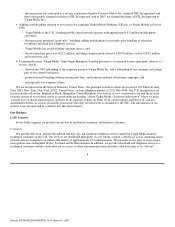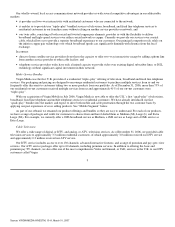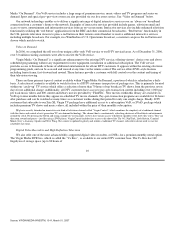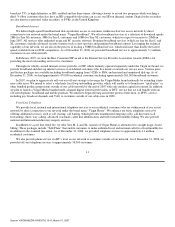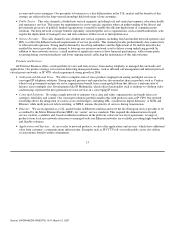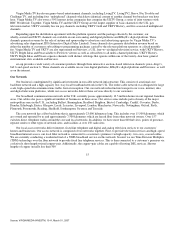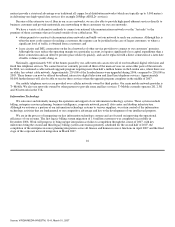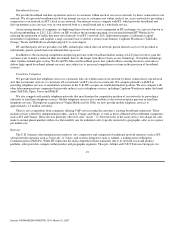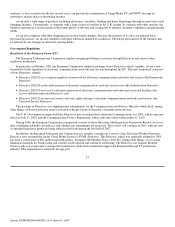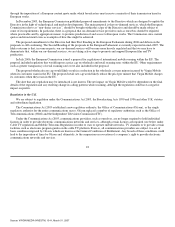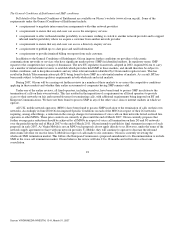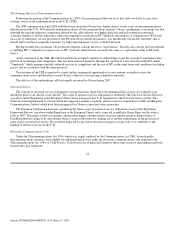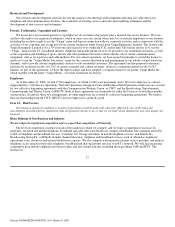Virgin Media 2006 Annual Report Download - page 22
Download and view the complete annual report
Please find page 22 of the 2006 Virgin Media annual report below. You can navigate through the pages in the report by either clicking on the pages listed below, or by using the keyword search tool below to find specific information within the annual report.
competition law prevent BSkyB from abusing its market position in relation to the supply of these channels to us. Even so we believe
that the current terms for this content are not reasonable and should be improved. We currently trade on BSkyB’s rate card terms and
pricing for their premium movie and sports channels. These terms can be changed on 30 days’ notice. Additionally, BSkyB has
refused to supply us certain enhancements to these services, such as High Definition TV content and “red button” functionality.
Residential customers may also receive digital terrestrial television, or DTT. Digital signals are delivered to customer homes
through a conventional television aerial and a separately purchased set−top box or an integrated digital television set. The free−to−air
DTT service in the U.K. is branded Freeview. This service is provided by a consortium of operators, including the BBC, and offers
customers a limited range of television channels, which include the traditional analog channels. Customers do not pay a monthly
subscription fee for basic Freeview service but must acquire a Freeview enabled set−top box or a television with a digital tuner.
Presently, Freeview does not offer several of the most popular pay television channels, such as UKTV Gold, LivingTV and MTV.
BSkyB has also announced its intention to remove its free channels (Sky News, Sky Sports News and Sky Three) from Freeview and
substitute pay channels.
Top Up TV offers a pay television service offering approximately nineteen pay television channels for a fixed fee to subscribers
who otherwise receive Freeview and have purchased Top Up TV software.
Currently a limited number of residential customers can receive DTV over BT’s ADSL lines. Video Networks Limited (bought
by Tiscali in 2006), under the brand name HomeChoice, supplies this service, including video on demand, to customers in parts of the
London metropolitan area, and Kingston Interactive Television supplies this service to customers in one region in England.
There are a number of new and emerging technologies which can be used to provide video services that are likely to compete
with our DTV and video on demand services. These include DSL services and third generation, or 3G, mobile telephony. Most
notably, BT has recently launched BT Vision, a combined DTT television service and a video on demand service over a DSL
broadband connection. BSkyB has also launched a video on demand service over a DSL broadband connection, and bundles that
service with its other offerings. Some other new competitors are using DSL technology to offer comparable bundling.
Pay television and pay−per−view services offered by us compete to varying degrees with other communications and
entertainment media, including home video, video games and DVDs.
Telecommunications is a constantly evolving industry and we expect that there will continue to be many advances in
communications technology and in content. These advances, together with changes in consumer behavior, and in the regulatory and
competitive environments, mean that it will be difficult to predict how our operations and businesses will be affected in the future.
The U.K. government has stated that it will terminate ATV transmission by 2012. Consumers wishing to receive television
services will have to convert to DTV, currently available via digital satellite, DTT, DSL or cable. However, when ATV transmission
is terminated, the terrestrial DTV signal and network may be strengthened. This will enable terrestrial DTV to be made available to
additional customers’ homes that cannot currently receive a signal. It may also provide additional capacity to allow the Freeview
channel line up to be expanded to include new channels.
There is also a growing demand and supply of full−length video content via broadband connections to the personal computer,
which can be a substitute for traditional television viewing. Content owners, online aggregators, television channel owners, etc. are
increasingly using broadband as a new digital distribution channel direct to consumers (primarily via downloading). Current business
models tend to be on a pay−per−transaction basis. This does represent a potential disintermediation threat to pay television platforms,
though the actual demand and willingness to pay for broadband distributed content is unlikely to represent sufficient revenues and
benefit to content owners to displace pay television as a preferred distribution channel for the near future.
18
Source: VIRGIN MEDIA INVESTM, 10−K, March 01, 2007


